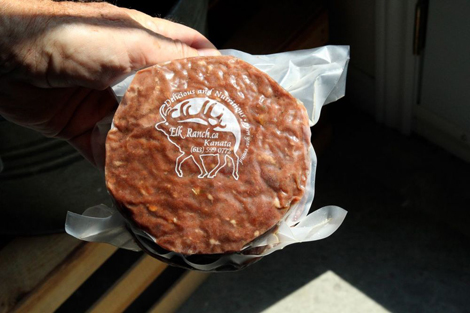 A WORLD OF UNUSUAL MEAT SOURCES
A WORLD OF UNUSUAL MEAT SOURCES
When it comes to meat, we all know the usual suspects: beef, pork, chicken. In travelling across the country, however, we’ve been struck by just how many alternatives there are in Canada, both domestic and wild.
We had our first introduction to the alternative meat scene by standing in the centre of a herd of bison, just south of Edmonton. This was both educational and terrifying, as we were able to see how massive these animals can grow to be – up to 2,500 pounds – and yet they’re so agile they can easily clear a five-foot fence. Bison rancher Gus Janke, of Maple Hills Farm, said the animals are (thankfully) not suited to feedlots and that their environment needs to be such that they’ll choose to stay, rather than be kept in by fences or wires. Their meat is lean, nutritious and free of hormones and steroids.
In Ontario, we found an alternative to conventionally-raised beef with Texas Longhorn cattle. Yes, also beef, but it’s of the toughest variety. Native to Texas, the Longhorns can be found around the world, including Australia and Canada, and are valued for lean meat and ability to survive harsh conditions. Bryan and Cathy Gilvesy raise their herd on YU Ranch, a farm strongly dedicated to principles of sustainability and environmental stewardship. We got to try a piece of BBQ’d Texas Longhorn prime rib – incredible!
Also in Ontario is The Elk Ranch, run by Thom Van Eeghen and his family outside of Ottawa. Their elk, like the bison and Texas Longhorns, are raised freely on acres of land, can survive the winter with little help and have tender, lean meat. Van Eeghen’s herd of elk live on 90 acres, grazing on a diverse range of food sources both in and outside of the forest. As the only elk producers in the area, education is a key part of building a market for this alternative meat and Van Eeghen sells most of his products to restaurants and at farmers markets. There, he can speak with consumers face to face about the benefits of elk as a food source.
During our travels, we’ve also had the opportunity to taste a variety of hunted meats, including deer, moose, black bear and, most recently, caribou and muskox in northern Manitoba and Nunavut. The muskox is a wild arctic animal that travels the tundra in search of moss, lichen and roots. They look like exceptionally shaggy bison and have been hunted by the Inuit for generations. The meat is leaner than beef, yet contains more moisture; the dish we ate at the Lazy Bear Lodge in Churchill was rouladen-style, with bacon and wild cranberries rolled in ground muskox. It was wonderful and especially good because we ate it with a view of the frozen tundra.
Diversify your animal proteins and seek out the alternative meat market! There are plenty of options in all parts of Canada. You just have to look.
FEAST: An Edible Road Trip is a cross-Canada adventure dedicated to sharing vibrant stories of Canadian food culture. Visit www.edibleroadtrip.com to read along. Also check out the perks for keeping FEAST on the road! (@feast_on)
By FEAST
